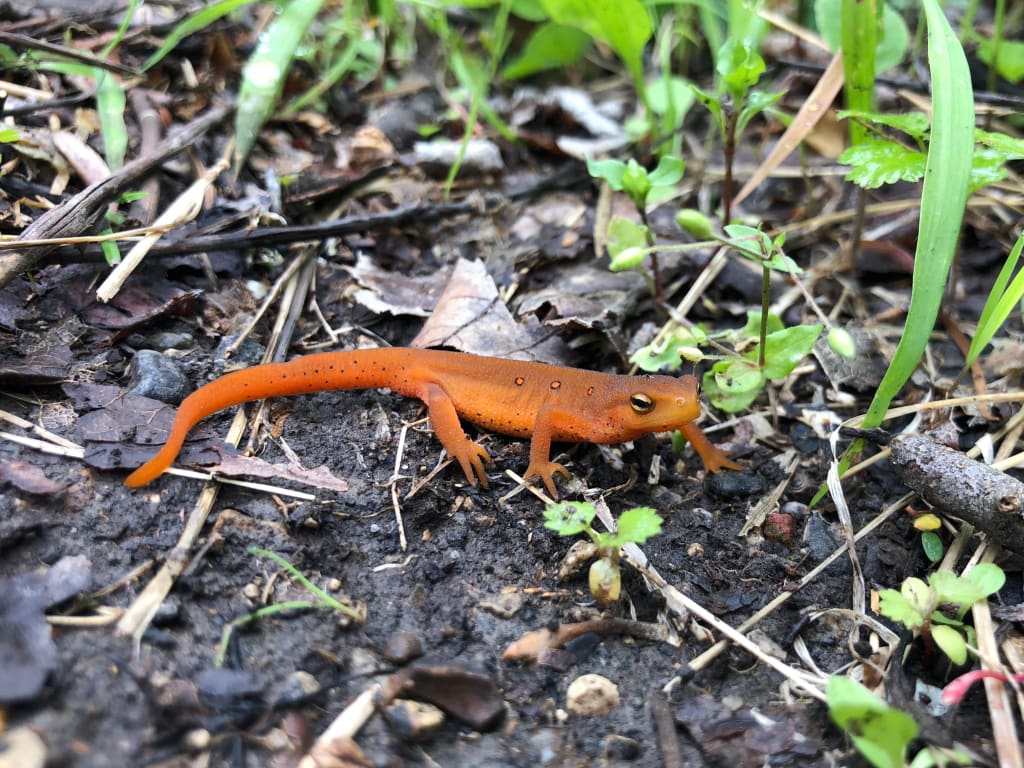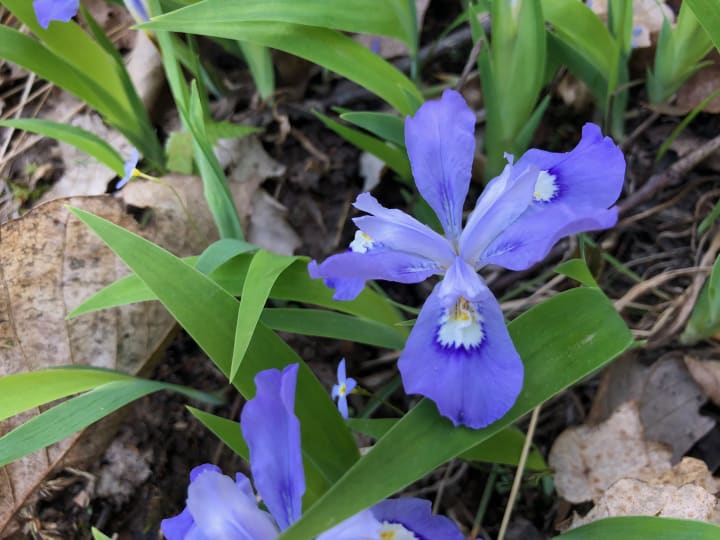Ode to the Red Eft
The beauty is in the tiny things.

It's late morning somewhere in North Carolina. I've been hiking alone so far today, mindlessly listening to music as my feet carve a repetitive step, step, step into the damp earth. It rained hard all night, and my friends and I woke up to sopping tents. But this morning, the sky is a crisp, cheerful blue, and the sun warms me as I walk.
The trail begins to rise slightly as I crest towards a clearing. A few yards ahead, I catch sight of a tiny spot of bright orange. What is that? I think, coming closer to the mysterious creature.
When I'm within a foot of it, my first thought is that it's a plastic toy lizard that someone has dropped. The orange is too vibrant, too artificial-looking, to be real. But when I kneel down for a closer look, the little head tilts up at me, slitted eyes curious and wary.
I let out an involuntary squeal of delight. "You're SO tiny!" I say. "Who are you?"
This is what hiking 2,200 miles will do to you. You start talking to red eft newts.
For this—red eft newt, or red eft salamander—is the name Google gave me when I searched "orange salamander North Carolina" the next time I had cell service.

A red eft is the second stage in the life cycle of the species Notophthalmus viridescens, also known as the eastern newt or the red-spotted newt. In this stage, they are extremely toxic if ingested, which explains why this little friend was strutting so fearlessly across the width of the Appalachian Trail on this cool, damp morning.
This was my first introduction to the red eft, but it would certainly not be my last. Once I saw my first one, I began spotting them all over the trail. I have since found them on many of my hikes in the Eastern part of the United States, usually after a night of heavy rain.
The Shot
My most recent red eft sighting came during a damp two-day backpacking trip at Tar Hollow State Park in southern Ohio. My boyfriend, Alex, and I always seem to pick the rainiest days to go backpacking—last fall, we slogged through three days of driving rain at Zaleski State Forest, and while this Tar Hollow trip wasn't quite on that level, we did still wake up squarely in the middle of a puddle after a relentless night of rain.
It was annoying to deal with all the wet gear in the morning, but it actually turned out to be a great day of hiking. The rain never did return on that second day, so we decided to do an 11-mile hike around the northern portion of the park.
As the trail rose higher into the hills, the woods became more and more vibrant, full of blooming wildflowers like great white trillium, fire pink, and dwarf crested iris.
As we were ascending one hill, Alex suddenly dropped to his knees in front of me. "Ah!" he exclaimed. "It's a red eft!"
Alex hiked the AT too—it's how we met—so he is also closely acquainted with the little salamanders. He turned his phone sideways, vertical again, trying to get a good shot, but the newt didn't want to cooperate with him.
"Can you see if you can get a picture?" Alex asked me.
I was still further down the hill, so I was in a prime location to take a photo before the red eft scampered away. I pulled out my phone from my pocket, turned it sideways, got as close as I could, and focused on the little orange face. Click. Then another. Click. Perfect.
I found myself wishing I'd brought my good camera, the Sony Alpha a6000 that I always forget to bring with me on local hikes. A smartphone picture doesn't hold a candle to the quality of shots that this camera produces. But still, I felt proud that I had timed it just right: in this photo, the red eft is looking back at me defiantly, in mid-stride, totally comfortable and in the right place.

After the Hike
We returned from Tar Hollow content, full of the satisfaction that only a good day on a trail can bring.
A while later, I revisited the photo of the red eft and smiled at the shot. I loved looking at those bright, confident eyes, the neon orange body with circular markings down the back. It was a pretty good shot, but I thought I could play around with some editing to make it even better.
The lighting on this hike was not ideal; it was one of those days that is cloudy, but somehow still bright. The exposure on this photo was therefore a bit too high, so I turned it down and boosted the saturation. I toggled back and forth on the brightness, striking the balance between too much and too little.
I'm no photographer. I have only a basic grasp of terminology and a very rudimentary understanding of editing. But I'm still pleased with the result.
There's something raw and real about a smartphone photo. Most long-distance hikers don't carry "real" cameras because they are too heavy. Instead, we rely on our phones for everything: navigation, communication, camera, notebook, music.
The photos we take on our phones may not be world-class photography, but they represent a life in motion, a quick observation before we move on. Much in the same way that a red eft moves across the trail, we move across a landscape, enjoying what we see in one moment before sauntering onward to the next.
Tiny Beauty
If there is one thing I have learned both from hiking and from the past year, it is that the most beautiful things in life are ones that are the easiest to overlook.
On the Appalachian Trail, there are few dramatic, sweeping vistas like there are in the Western United States. Instead, there are small, intricate details. Red eft newts. Chicken-of-the-woods. Bee balm. In the absence of wide panoramas, our eyes are drawn downward, to the woods and the forest floor. This is where the life is. This is where the beauty, the tiny minuscule wild beauty, waits to be seen.
I'm a person who likes to move around. The pandemic has been hard for me, like so many others who yearned to travel. In the absence of dramatic far-flung adventures, I found quieter, more patient ones closer to home.
I watched the seasons changing in more detail than I ever had before. I started foraging mushrooms and learned the names of wildflowers. I visited local parks that I'd never been to.
And I appreciated the beauty of the red efts.

Thank you for reading! If you enjoyed this story, please let me know by clicking the heart button below. If you really liked it, please share on social media. If you really, REALLY liked it, you could leave me a tip! I appreciate you.
About the Creator
Sarahmarie Specht-Bird
A writer, teacher, traveler, and long-distance hiker in pursuit of a life that blends them all. Read trail dispatches and adventure stories at my website.






Comments
There are no comments for this story
Be the first to respond and start the conversation.